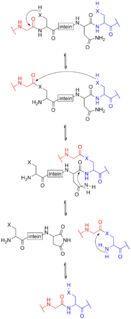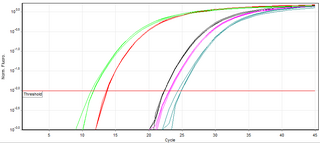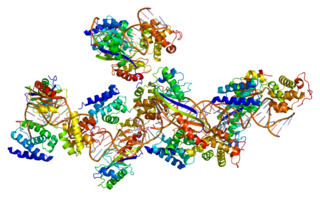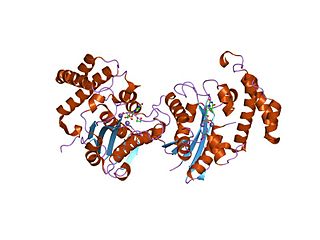
Polymerase chain reaction (PCR) is a method widely used in molecular biology to make many copies of a specific DNA segment. Using PCR, a single copy of a DNA sequence is exponentially amplified to generate thousands to millions of more copies of that particular DNA segment. PCR is now a common and often indispensable technique used in medical laboratory and clinical laboratory research for a broad variety of applications including biomedical research and criminal forensics. PCR was developed by Kary Mullis in 1983 while he was an employee of the Cetus Corporation. He was awarded the Nobel Prize in Chemistry in 1993 for his work in developing the method.

In genetics, a promoter is a region of DNA that initiates transcription of a particular gene. Promoters are located near the transcription start sites of genes, on the same strand and upstream on the DNA . Promoters can be about 100–1000 base pairs long.

RNA polymerase, both abbreviated RNAP or RNApol, official name DNA-directed RNA polymerase, is a member of a family of enzymes that are essential to life: they are found in all living organisms and many viruses. RNAP locally opens the double-stranded DNA so that one strand of the exposed nucleotides can be used as a template for the synthesis of RNA, a process called transcription. A transcription factor and its associated transcription mediator complex must be attached to a DNA binding site called a promoter region before RNAP can initiate the DNA unwinding at that position. RNAP has intrinsic helicase activity, therefore no separate enzyme is needed to unwind the DNA. RNAP not only initiates RNA transcription, it also guides the nucleotides into position, facilitates attachment and elongation, has intrinsic proofreading and replacement capabilities, and termination recognition capability. In eukaryotes, RNAP can build chains as long as 2.4 million nucleotides.

An intein is a segment of a protein that is able to excise itself and join the remaining portions with a peptide bond in a process termed protein splicing. Inteins have also been called "protein introns".

Hepadnaviridae is a family of viruses. Humans, apes, and birds serve as natural hosts. There are currently seven species in this family, divided among 2 genera. Its best-known member is the hepatitis B virus. Diseases associated with this family include: liver infections, such as hepatitis, hepatocellular carcinomas, and cirrhosis.
dnaQ is the gene encoding the ε subunit of DNA polymerase III in Escherichia coli. The ε subunit is one of three core proteins in the DNA polymerase complex. It functions as a 3’→5’ DNA directed proofreading exonuclease that removes incorrectly incorporated bases during replication. dnaQ may also be referred to as mutD.
RNA polymerase 1 is, in higher eukaryotes, the polymerase that only transcribes ribosomal RNA, a type of RNA that accounts for over 50% of the total RNA synthesized in a cell.

RNA polymerase II is a multiprotein complex. It is one of the three RNAP enzymes found in the nucleus of eukaryotic cells. It catalyzes the transcription of DNA to synthesize precursors of mRNA and most snRNA and microRNA. A 550 kDa complex of 12 subunits, RNAP II is the most studied type of RNA polymerase. A wide range of transcription factors are required for it to bind to upstream gene promoters and begin transcription.

General transcription factors (GTFs), also known as basal transcriptional factors, are a class of protein transcription factors that bind to specific sites (promoter) on DNA to activate transcription of genetic information from DNA to messenger RNA. GTFs, RNA polymerase, and the mediator constitute the basic transcriptional apparatus that first bind to the promoter, then start transcription. GTFs are also intimately involved in the process of gene regulation, and most are required for life.

A real-time polymerase chain reaction, also known as quantitative polymerase chain reaction (qPCR), is a laboratory technique of molecular biology based on the polymerase chain reaction (PCR). It monitors the amplification of a targeted DNA molecule during the PCR, i.e. in real-time, and not at its end, as in conventional PCR. Real-time PCR can be used quantitatively, and semi-quantitatively, i.e. above/below a certain amount of DNA molecules.

Transcription factor II B (TFIIB) is a general transcription factor that is involved in the formation of the RNA polymerase II preinitiation complex (PIC) and aids in stimulating transcription initiation. TFIIB is localised to the nucleus and provides a platform for PIC formation by binding and stabilising the DNA-TBP complex and by recruiting RNA polymerase II and other transcription factors. It is encoded by the TFIIB gene, and is homologous to both archaeal transcription factor B and more distantly to bacterial sigma factors

DNA polymerase, beta, also known as POLB, is an enzyme present in eukaryotes. In humans, it is encoded by the POLB gene.

General transcription factor IIH subunit 2 is a protein that in humans is encoded by the GTF2H2 gene.

DNA-directed RNA polymerase, mitochondrial is an enzyme that in humans is encoded by the POLRMT gene.

DNA polymerase delta subunit 4, also known as DNA polymerase delta subunit p12, is a protein that in humans is encoded by the POLD4 gene. It is a component of the DNA polymerase delta complex.

General transcription factor IIE subunit 2 (GTF2E2), also known as transcription initiation factor IIE subunit beta (TFIIE-beta), is a protein that in humans is encoded by the GTF2E2 gene.

In molecular biology, holA is a gene that encodes the δ (delta) subunit of DNA polymerase III in E. coli and other bacteria. Along with the γ, δ', χ, and ψ subunits that make up the core polymerase, and the β accessory proteins, the δ subunit is responsible for the high speed and processivity of polIII.

In E. coli and other bacteria, holE is a gene that encodes the theta subunit of DNA polymerase III.

DNA polymerase alpha catalytic subunit is an enzyme that in humans is encoded by the POLA1 gene.


















